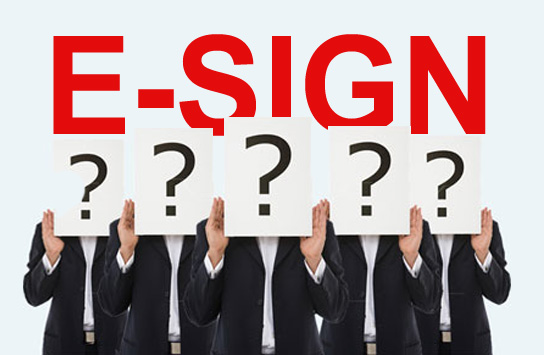 E-SIGN is getting more attention than ever, it seems. In the past few months, our offices have fielded numerous questions regarding the E-SIGN Act and we have been asked to teach four webinars on the subject. The reason E-SIGN is getting so much attention now is that regulatory and technological changes are forcing the industry to find new ways of achieving compliance in a cost-effective manner, which almost always involves the use of electronic signatures or providing important documents electronically. For example, the Right to an Appraisal changes made to Regulation B have forced lenders who do a lot of mortgage loans to provide large numbers of appraisals economically and, consequently, electronically.
E-SIGN is getting more attention than ever, it seems. In the past few months, our offices have fielded numerous questions regarding the E-SIGN Act and we have been asked to teach four webinars on the subject. The reason E-SIGN is getting so much attention now is that regulatory and technological changes are forcing the industry to find new ways of achieving compliance in a cost-effective manner, which almost always involves the use of electronic signatures or providing important documents electronically. For example, the Right to an Appraisal changes made to Regulation B have forced lenders who do a lot of mortgage loans to provide large numbers of appraisals economically and, consequently, electronically.
Furthermore, the demand for electronic products and services is growing, including mobile banking, remote deposit transfers, e-statements, and online banking. These products and services must provide federally required disclosures in an electronic format that necessarily require electronic signing. This widespread use has financial institutions and even regulators taking a second look at E-SIGN requirements.
Introduction
The Electronic Signatures in Global and National Commerce Act was signed into law on June 30, 2000 by President Clinton. The E-SIGN Act established the legitimacy of electronic documents and signatures in interstate or foreign commerce. It also made electronic documents acceptable to satisfy any statute, regulation or rule of law requiring that such information be provided in writing, if the consumer has affirmatively consented to such use and demonstrated the ability to access the documents. Although it seems fairly straightforward, we still receive a lot of questions about E-SIGN compliance. Some of these common questions include:
- We do not open online accounts but offer paperless statements. Is E-SIGN required?
Yes, E-SIGN is applicable. This is a good example of where affirmative consent is needed. You must provide consumers with the E-SIGN notice (about 3 paragraphs explaining the consumer’s rights to withdraw consent and receive paper statements, how to do so, and the software/hardware requirements needed to receive disclosures electronically). This may already be written into your e-statements agreement. This can be a blanket consent for all electronic documents or consent just for this product.
- Can we decline a deposit account if the consumer declines to receive electronic statements?
You cannot require consumers to use electronic records. E-SIGN gives the consumer a right to request and receive paper records. However, you are permitted to charge a reasonable fee for photocopying or hardcopy records.
- Do we have to notify the customer every time there is a change in our hardware or software requirements?
The act requires that if, after consent is provided, a change is made in the hardware or software requirements needed to access or retain the electronic disclosures, and the change creates a material risk that the consumer will not be able to access or retain an electronic disclosure that was the subject of the prior consent, the consumer must be provided with an appropriate notice of the change and must re-consent electronically in a manner that reasonably demonstrates the consumer’s ability to access the electronic notice or disclosure.
- If the ECOA appraisal regulation applies to certain business loans, we do not need to follow the E-SIGN requirements per my understanding. Can we just email the business the appraisal or is there a more acceptable practice?
The first part of E-SIGN establishes the validity of electronic records and signatures for all commerce or trade. This is true for everyone, but the consumer protection requirements (the E-SIGN notice, the right to opt out, affirmative consent) are just for individual consumers, not for businesses. You may provide business appraisals however you choose and so email is acceptable. You must ensure that the electronic document (appraisal) is accurate, can be reproduced by the recipient, and is provided in a secure or safe manner for all customers business or consumer.
- When a person signs up for e-statements, does the institution have an obligation to verify that the customer is able to view their statement and the ability to prove the customer has viewed it? For instance, once the customer accepts receiving e-statements, do we need to send the customer a sample e-statement and have the customer verify that they can read the statement?
E-SIGN requires that the consumer consent “in a manner that reasonably demonstrates that the consumer can access information in the electronic form that will be used to provide the information that is the subject of the consent.” This can be accomplished in various ways including test documents, pin codes, and clicking links. You are not obligated to confirm that the consumer is opening or reading the electronic documents only that they can if they so choose.
These are just five of dozens of other questions about E-SIGN. As you can see, for a three-page regulation, it sure generates a lot of questions, and that is due in part to its increasing importance in this technological era. For more information on E-SIGN and how AffirmX can assist you with E-SIGN as part of its package of compliance services, please contact alberto.gamez@affirmx.com.
Stay tuned for our article next week which will feature more common E-SIGN questions, this time about affirmative consent, demonstrating access, record retention, and more.




